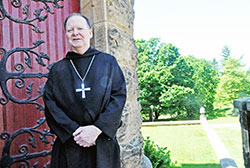Monks of Saint Meinrad see Benedictine qualities in late pontiff

Benedictine Archabbot Kurt Stasiak stands on June 6, 2016, next to the Archabbey Church of Our Lady of Einsiedeln in St. Meinrad. He and the Benedictine monks of
Saint Meinrad Archabbey found special meaning in the ministry of the late Pope Benedict XVI, who honored the founder of their order in his choice of his papal name.
(File photo by Sean Gallagher)
By Sean Gallagher
After the death of Pope Benedict XVI was announced on Dec. 31, 2022, the Benedictine monks of Saint Meinrad Archabbey in
St. Meinrad did what they have done when a pontiff dies since their monastery was founded in 1854.
They tolled a bell in their Archabbey Church of Our Lady of Einsiedeln once for each year of his pontificate and then pealed all six of its bell for two minutes.
Although this is a tradition carried out for all pontiffs, Pope Benedict had a special meaning for the monks of Saint Meinrad since his papal name honors St. Benedict, the sixth-century founder of the Benedictine order.
St. Benedict dedicated a long chapter in his Rule to reflecting on the importance of humility in the life of monks. Benedictine Archabbot Kurt Stasiak saw the humility of the late pontiff as a prime Benedictine quality in his ministry.
“He was a brilliant scholar but always used his scholarship to serve the Church, not to promote himself,” Archabbot Kurt said in an interview with The Criterion. “At the same time, here was a man who I believe had a keen sense of his own weaknesses and inadequacies.”
Quoting a phrase from St. Paul’s Second Letter to the Corinthians, Archabbot Kurt said that he believed Pope Benedict “genuinely considered himself an ‘earthen vessel,’ unworthy in himself to hold his position but dedicated to fulfilling it as best as he could, always relying upon God’s grace.”
In his homily during a Jan. 5 memorial Mass for Pope Benedict at the Archabbey Church, Archabbot Kurt reflected on Pope Benedict’s humility in light of the example of his predecessor, St. John Paul II, both of whom he said were valuable witnesses for the Church.
“Pope John Paul II reigned for 26 years, the last handful of which involved a constant struggle with Parkinson’s disease,” Archabbot Kurt said. “He would not give up. What an example of perseverance and determination.
“Pope Benedict’s leadership lasted almost eight years. He gave it everything he could. And when he could no longer give … he handed back to the master the talents he had been entrusted with, and he handed them back with interest.
“What an example of confidence and trust. Humble confidence and gracious trust in the Lord.”
Benedictine Father Paul Nord is a monk of Saint Meinrad who was a graduate student in Rome while Pope Benedict was serving as the city’s bishop. He was there when he stepped down as pope in 2013 and took part in his last public liturgy as pope on Ash Wednesday.
Now an instructor of Scripture at Saint Meinrad Seminary and School of Theology in St. Meinrad, Father Paul saw the late pope’s love for liturgy as an important Benedictine quality of his life and ministry as bishop of Rome.
“As Benedictines, our daily common liturgy is the glue that holds our community together as we seek Christ together,” Father Paul said in an interview with The Criterion. “Likewise for Pope Benedict, his daily celebration of the eucharistic liturgy nourished his priestly vocation and Christian faith. Pope Benedict was a world-class theologian whose every word was inspired by his daily encounter with Christ in the liturgy.”
The priest also noted how Pope Paul VI had named St. Benedict as a patron saint of Europe for the vital role Benedictine monks played in its evangelization beginning 1,500 years ago.
“Pope Benedict prayed and worked tirelessly for what he described as a ‘new springtime for Christianity’ in Europe,” Father Paul said. “Like St. Benedict, Pope Benedict’s witness to Christ Jesus planted seeds of faith that will bear fruit long after his death.”
On the day of his election in 2005, Pope Benedict described himself as “a simple and humble laborer in the vineyard of the Lord.” Those words came to mind often for Father Paul when he lived in Rome during the late pope’s pontificate.
“Every Ash Wednesday, Pope Benedict would visit our Benedictine community at Sant’Anselmo,” Father Paul recalled. “Celebrating the eucharistic liturgy, his bearing combined gentle humility and careful labor. He celebrated the liturgy with precision and deep reverence.
“Up close, Pope Benedict carried himself as ‘a simple and humble laborer’ who tranquilly trusted in Christ’s grace to help him fulfill the papal ministry.” †
See all our coverage of the death of Pope Emeritus Benedict XVI
